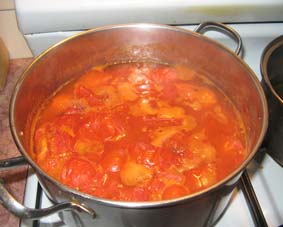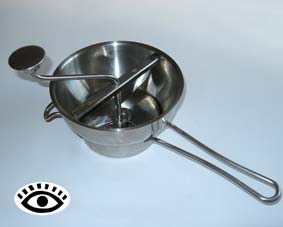processing garden produce
tomato puree
Peeled tomatoes is my preferred method of
preserving tomatoes but for that
you need reasonably sized firm tomatoes. For smaller and
softer tomatoes I revert to pureeing them. This
page explains how to puree tomatoes using a mouli . It
also briefly looks at some alternative methods.
description of a mouli
A mouli is a circular bowl with a sieve at the bottom and an angled
plate of metal that is rotated by a shaft with a handle on it.
The rotating process pushes the tomatoes through the sieve whilst
leaving most of the skins. It is easy to clean as all the parts can be quickly
separated and put back
together again. This ease makes it very suitable for processing
small batches of tomatoes.There are a number of moulis on the market of differing sizes and qualities. The one displayed here is a Gefu Mouli made in Germany. I have found it to be excellent, extremely robust and capable of processing several Kilos of tomatoes in short order.
pureeing tomatoes using a
mouli

Chopped tomatoes in a pot ready to stew.

Chopped tomatoes being cooked. After
coming to the boil stew the tomatoes for about an hour.

Pushing the tomatoes through the mouli sieve.

The handle and plate section of the mouli lifted to show the
skins left after the stewed tomatoes have been pushed
through.
- Wash tomatoes and cut them into pieces (halve small
tomatoes and quarter large ones) cutting out bad sections
you find and removing any stems.
- Place the tomatoes in a large pot and bring to a boil,
stirring the mixture occasionally. Do not put a lid on
it.
- Boil the tomatoes for about an hour. This done to
make sure the tomatoes are totally cooked and to render down
the mixture to a more concentrated state.
- Get a pot or bowl of similar size to the pot the
tomatoes are cooking in and place the mouli on top.
- Ladle or pour stewed tomatoes into the mouli until it is
almost full then
turn the handle until empty. If you are processing a
large amount of tomatoes then at regular intervals remove
the paddle and empty out the skins that
are trapped between the paddle and the sieve.
- The sieved pulp is now ready to bottle using the Fowlers Vacola bottling method . I use Fowlers Jars and large screw top jars, however the pulp is still runny enough to be poured into bottles.
other points to consider
when using a mouli
I prefer a fairly runny tomato puree as I think it doesn't
take much to render it down further as you are cooking with it.
However if you prefer more of a tomato paste texture then you
can slowly boil the puree for another two or three hours after it
has been sieved.Many of the moulis on the market come with extra sieve attachments with larger or smaller holes. I have gardening friends who put the pulp mixture through their mouli twice, using a smaller hole size sieve the second time. But I find this unnecessary.
I stop rotating the mouli as soon as all the pulp has disappeared. By doing this I maximise the number of skins I retain in the sieve. But if you continue to rotate the mouli after then you will literally drive most of the skins through the sieve as well. But as I prefer to remove as many skins as possible it do not do this.
alternatives to using a
mouli to make tomato puree
Electric hand blender
Electric hand blenders such as a
Bamix are excellent
for pureeing stewed tomatoes, until I bought a mouli I used a Bamix for
this purpose for many years. The only real difference between
using a Bamix and a Mouli is that a Bamix can't separate out the
skins.Tomato sauce maker

Tomato sauce maker
courtesy of the internet.
courtesy of the internet.
Unless you are fussy about seeds in your tomato puree and have a lot of tomatoes to process then a tomato sauce maker is, in my view, overkill. A gardening friend of mine processes on average 150 kg of tomatoes each season and he does it all with a mouli.


